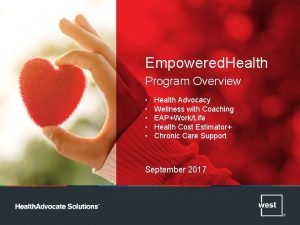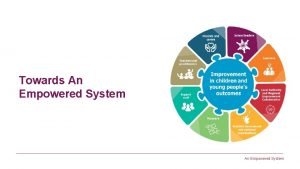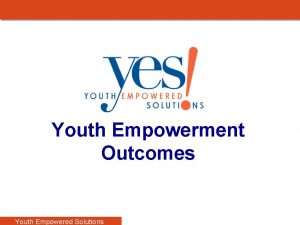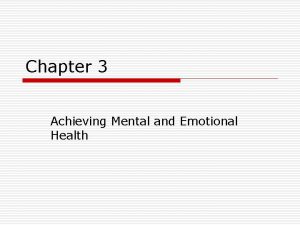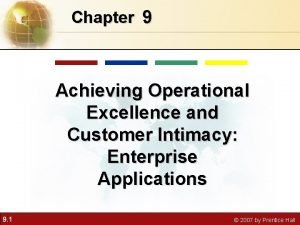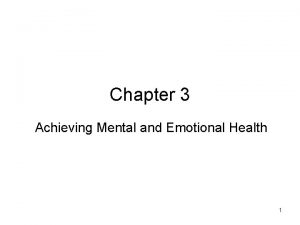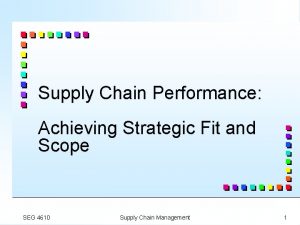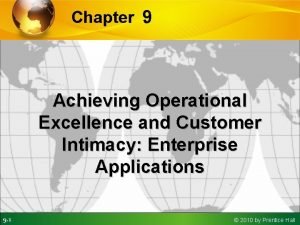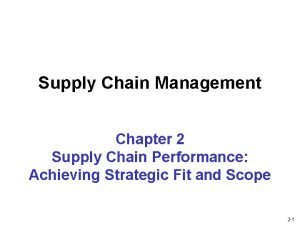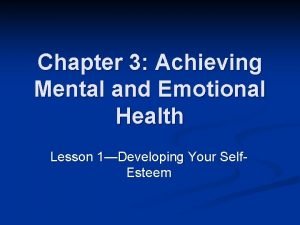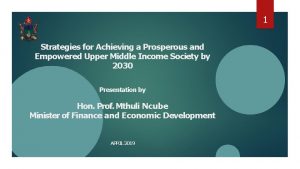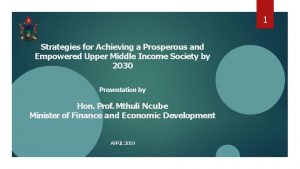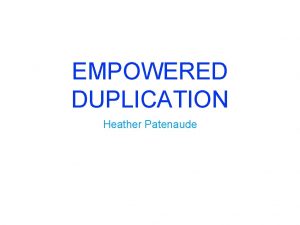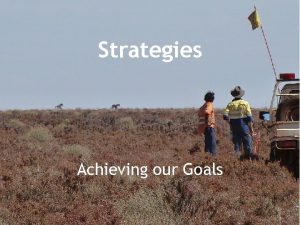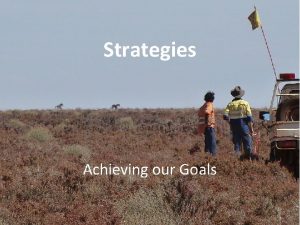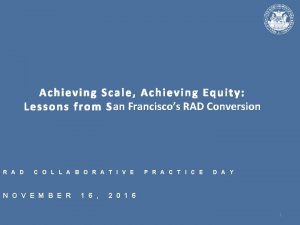1 Strategies for Achieving a Prosperous and Empowered




































- Slides: 36

1 Strategies for Achieving a Prosperous and Empowered Upper Middle Income Society by 2030 Presentation by Hon. Prof. Mthuli Ncube Minister of Finance and Economic Development APRIL 2019

2 Outline 1. Introduction 2. Vision 2030 and TSP 3. Progress on Economic Reforms 4. Monetary Sector Reforms 5. Institutional and Political Reforms 6. Arrears Clearance 7. Cyclone 8. Sector Idai Focus

Introduction 3 The new Government, guided by His Excellency, the President, E. D. Mnangagwa, is on a transformative journey aimed at re-building the economy to realise the Vision 2030 goals of a ‘Prosperous and Empowered Upper Middle Income Society’; This initiative is in line with continental and inter-continental commitments towards attainment of the Sustainable Development Goals and the AU Agenda 2063; The aim is to improve the livelihoods of the majority of Zimbabweans through improved access to basic services and higher incomes; This can only be achieved through good governance based on the rule of law, as well as respect for human and property rights;

Introduction cont 4 The New Dispensation – breakaway from the past; Zimbabwe is undertaking international re-engagement (political and economic); Vision 2030, seeks to transform Zimbabwe into an Upper Middle Income Economy by 2030; Transitional Stabilisation Programme (October 2018 – December 2020 )is the policy implementation programme for Vision 2030;

5 ZIMBABWE VISION 2030 Governance Macro. Economic Stability & Financial Re. Engagement Inclusive Growth Infrastructure & Utilities Cross Cutting Themes Social Development

Vision 2030 values & objectives 6 Improved Governance and the Rule of Law. Re-orientation of the country towards Democracy. Upholding Freedoms of Expression and Association. Peace and National Unity. Respect for Human and Property Rights. Attainment of Responsive Public Institutions. Broad based Citizenry Participation in national and socio-economic development programmes. Political and Economic Re-engagement with the global community. Creation of a Competitive and Friendly Business Environment. Enhanced domestic and foreign investment. An aggressive fight against all forms of Corruption.

Roadmap to Vision 2030 7 Government has a roadmap to ensure attainment of the people’s aspirations under Vision 2030. The roadmap involves a staged approach with the first phase being the ongoing implementation of the Transitional Stabilisation Programme up to 2020. The second and third stages involve the formulation and implementation of two five year national development strategies. The step-by-step approach allows for prioritisation of policies and interventions necessary for setting of the foundations for a longer term sustainable growth over the Vision 2030 horizon.

Roadmap to Vision 2030 cont 8 Two Five Year Development Plans The subsequent two five-year development plans will focus on putting in place the appropriate hard infrastructure in place, in the areas of energy, transport, as well as water and sanitation, among others. In addition, investment in soft infrastructure in the form of ICT will be advanced.

Transitional Stabilisation Programme 9 Stabilising the macro-economy, and the financial sector. Introducing necessary policy, and institutional reforms, to transform to a private sector led economy. Launching quick-wins to stimulate growth, as well as to attract and encourage foreign direct investment.

Reversing Macro-Economic Imbalances Macro-economic Environment. Restoration of Fiscal Balance Mobilising Domestic Savings. Competitiveness of Exporters. 10

11 Upper Middle Income Society q. Despite all the challenges, the economy still remains vibrant. q. Target per capita income level of at least US$4 500 by 2030. q. This implies a sustained growth in nominal GDP from the 2018 levels of around US$25 billion to around US$65 billion by 2030. q. The private sector is expected to stimulate growth, with Zimbabwe assuming the position of a factory to the world. q. This will be complemented by increased competition to bring down prices.

Leveraging Zimbabwe 12 Zimbabwe as the gateway into Africa. Zimbabwe as a regional transit country. Zimbabwe as gateway for Africa into the World. Zimbabwe as factory for Africa.

13 Progress on TSP and Road to Vision 2030

Fiscal Intervention 14 Treasury has a big role to play in terms of attainment of the Vision 2030 through providing an enabling environment, and also availing fiscal incentives in the Special Economic Zones to stimulate domestic production. Going forward, Treasury will continue with fiscal prudence by adhering to fiscal rules, to ensure a stable macro-economic environment. Government will crowd in the private sector in the development of public infrastructure, as a way of sharing the financial burden and promoting the local industry.

15 Fiscal Consolidation Public Finances: Jan 2018 –Jan 2019 The target is to reduce budget deficits from about 12% of GDP in 2018 to 5%in 2019. Revenue collection Jan-19 Dec-18 Nov 18 Oct 18 Sep 18 Aug 18 Jul 18 Jun 18 May 18 Apr-18 Mar 18 Feb 18 Jan-18 US$ Million Jan-18 Feb-18 Mar-18 Apr-18 May-18 Jun-18 Jul-18 Aug-18 Sep-18 Oct-18 Nov-18 Dec-18 Jan-19 Revenue Expenditure Budget Balance 2%Intermediated Mobile Transfer Tax Improvement of Tax Administration Expenditure Containment Measures Treasury Bills Public Wage Bill (5% salary cut for senior Government Officials; Rationalisation of posts) 13 th Cheque Payment Freeze on Hiring Procurement of vehicles Average surplus of US$100 million a month since September 2018

Wage Bill Containment Measures 16 Maintaining freeze on filling non-critical posts. Enforcing Retirement Policy. Implementation of new policy on Personal Issue Vehicles. Rationalisation of Foreign Service Missions. Reviewing conditions of service for Locally Recruited Staff at our Diplomatic Missions. Relating outlays on bonus payments to Budget financial capacity. Interfacing the Payroll & Pension Systems, Public Finance Management System and the HR Management Information System. Strengthening payroll controls.

Key Infrastructure Projects Beitbridge – Harare – Chirundu Highway. Beitbridge – Victoria Falls Highway. Hwange 7 & 8. Batoka Gorge Dam and Power Station Kondo Dam. The Ministry of Environment, Water and Climate has also floated tenders for international projects. 17

18 Inflation Year on year inflation recorded 56. 7% by January 2019 from 20. 9% in October and 5. 4% in September 2018 Government has, therefore, further strengthened efforts on implementation of fiscal consolidation measures targeting narrowing the fiscal deficit and slowing down money supply growth starting in October 2018 This has seen month-on-month inflation slowing down to 9. 2% and 9%in November and December 2018, from 16% in October 2018 Monthly inflation for February 2019 is 1. 7%, whilst the inflation trend isdownward Jan 17 Feb 17 Mar 17 Apr-17 May 17 Jun-17 Jul-17 Aug 17 Sep 17 Oct-17 Nov 17 Dec 17 Jan-18 Feb 18 Mar 18 Apr-18 May 18 Jun-18 Jul-18 Aug 18 Sep 18 Oct-18 Nov 18 Dec 18 Jan-19 Inflation Developments Inflation Parrel Market Exchange Premiums Money Supply Growth

19 Domestic Debt Treasury stopped resorting to the RBZ overdraft facility; US$ billion In 2018, payments towards domestic debt amounted to US$1. 62 billion. In January and February 2019 payments towards domestic debt amount to US$195 million 2013 2014 2015 Debt Stock 2016 2017 Repayment 2018 2019

Options for Arrears Clearance Government is committed to implementing reforms and completing the Arrears Clearance Road Map; The fiscal reform and re-engagement efforts are setting the country back in the arrears clearance plan; Government will continue engaging all bilateral and multilateral creditors. 20

21 Monetary Sector and Currency Reforms � Separation of FCA accounts and RTGS accounts in October 2018 - set the tone for the implementation of currency reforms � Liberalisation of the exchange rate – establishment on an Inter-Bank Foreign Currency market; � Setting up of a robust market based framework for determination of the exchange rate to facilitate financial sector stability, containment of inflationary pressures and building of confidence

22 Monetary Sector and Currency Reforms Conversion of local USD accounts into RTGS dollar accounts; Use of RTGS dollar as reference currency; Removal of distortions including multi-tier pricing of goods and services (USD, Bond Notes, RTGS, Ecocash)

23 State Owned Enterprises and Parastatals Reforms GMB: unbundling of the Grain Marketing Board into Strategic Grain Reserve Unit and Commercial Entity Allied Timbers ZESA: re-bundling of ZESA and to merge all the 5 separate units into a single integrated company with one board Lotteries and Gaming Board National Competitiveness Commission Partial privatisation of the Industrial Development Corporation of Zimbabwe …. Willowvale Motor Industries Partial privatisation of Net. One and Tel. One

24 Sector Focus

Importance of Reviving the Manufacturing Sector 25 The country has been exporting raw products, while importing finished products, sustaining widening of the current account deficit. The solution to this current account deficit lies in value addition and beneficiation, so that the country earns higher value on the foreign market. High levels of formal unemployment can also be easily addressed by resuscitation of the manufacturing sector.

Resuscitation of Distressed Companies The economy used to boast of countrywide strategic companies which 26 employed a significant number of workers with strong backward and forward linkages with the rest of the economy. Some of the companies include David Whitehead Textiles, Cold Storage, Border Timbers, Railways of Zimbabwe, Hwange Colliery and Zimbabwe Iron and Steel Company, among others. As a result, Government will make deliberate and targeted interventions to facilitate the re-opening and resuscitation of such companies through various financing mechanisms particularly joint ventures with private investors. Furthermore, Government will advance the ongoing State Owned Enterprise reforms to improve service delivery and reduce the financial burden on the fiscus.

Strategies to Revive Production 27 Government is in the process of fully operationalising Special Economic Zones to help attraction of investment, technology transfer, beneficiation and value addition, creation of employment and generation of exports. The target is to complete the following: Ø Sunway City in Harare, focussing on the high technology hub; Ø Victoria Falls, covering tourism and financial services; Ø Bulawayo, focussing on beef to leather industry, cotton to textile industry, steel and foundry, and the rehabilitation of the NRZ, among other value chains; and Ø Mutare Special Economic Zone, which will focus on diamond cutting and polishing.

Ease of Doing Business Reforms Rankings on Doing Business: Zimbabwe (2018) 0 20 40 60 80 100 120 140 160 180 108 180 175 161 105 89 143 153 166 155 28 Establishment of a One-Stop Shop Investment Centre. Currently in the process of amalgamating the Joint Venture Unit, Zimbabwe Special Economic Zones Authority and the Zimbabwe Investment Authority into the Zimbabwe Investment and Development Agency Bill now before Parliament.

29 Agriculture q. Zimbabwe’s agricultural sector is flush with investment opportunities. q. Agriculture remains a mainstay of the Zimbabwean economy, accounting for 10. 5% of GDP in 2017 and employing 60 -70% of the workforce. q. The el-nino induced drought during the 2018/2019 agricultural season might see revised forecasts of agricultural output

30 Mining q World-Class Geological Endowment: All 40 major minerals have been identified. q Second largest platinum reserves and second largest producer of ferrochrome in Africa. q Zimbabwe requires an estimated US$11 billon of Capex to modernise its existing mines. q Furthermore, almost all minerals are exported from Zimbabwe in their unprocessed state. This allows opportunities for investors in the value-add stage of production. q Zimbabwe’s highly anticipated gold sector is on a ten-year growth path.

31 Institutional Reforms

32 Legislative Agenda Repeal of Public Order and Security Act (POSA) and Access to Information and Protection of Privacy Act (AIPPA). Cyber Protection, Data Protection, and Electronic Transactions Bill Citizenship laws Police Act Political Dialogue

33 Legislative Agenda 1. Indigenisation and Economic Empowerment Act amended; 2. The companies and Other Entities Bill; 3. The Regional Town and Country Planning Amendment Bill; 4. The Zimbabwe Investment and Development Agency Bill; 5. The Citizenship of Zimbabwe Act and the Immigration Act to be amended; 6. The Mines and Minerals Amendment Bill; 7. The Gold Trade Bill and the Precious Stones Trade Bill; 8. The Institute of Education Research, Innovation and Development Bill; 9. Consumer Protection Bill; 10. Zimbabwe 11. Cyber Media Commission Bill and amendment of the Broadcasting Services Act; Crime & Cyber Security Bill;

34 Land Reform Government is commited to implement the Constitution requirement for compensation; Government is finalising valuation of farms to engage farmers who have already completed their valuations; A Cabinet Committee is in place to spearhead discussions between Government and farmers; Some compensation had began, but discontinued to allow Government to carryout a wholesome compensation programme; After completion of valuations and engagements with farmers on the total value of the compensation – likely options for compensation will be to treat the value as domestic debt or foreign debt. Creation of a "Land Bank" would allow the debt to be off balance sheet. Sale of land around major urban areas

35 Devolution $319 million allocated in 2019; Afocus is on projects that create jobs; Resource allocation based on quality of infrastructure, levels of poverty and population size.

36 I THANK YOU
 Empowered health and wellness
Empowered health and wellness Empowered system
Empowered system Youth empowered solutions
Youth empowered solutions Empowered success teachable
Empowered success teachable Chapter 21 a unique prosperous and discontented time
Chapter 21 a unique prosperous and discontented time Chapter 3 achieving mental and emotional health answer key
Chapter 3 achieving mental and emotional health answer key Chapter 3 achieving mental and emotional health
Chapter 3 achieving mental and emotional health Chapter 15 achieving mental and emotional health answer key
Chapter 15 achieving mental and emotional health answer key Achieving operational excellence and customer intimacy
Achieving operational excellence and customer intimacy Chapter 3 achieving mental and emotional health
Chapter 3 achieving mental and emotional health Chapter 3 achieving mental and emotional health
Chapter 3 achieving mental and emotional health Chapter 15 achieving mental and emotional health answer key
Chapter 15 achieving mental and emotional health answer key Chapter 15 achieving mental and emotional health answer key
Chapter 15 achieving mental and emotional health answer key Supply chain performance achieving strategic fit and scope
Supply chain performance achieving strategic fit and scope Achieving operational excellence and customer intimacy
Achieving operational excellence and customer intimacy Scope of strategic fit
Scope of strategic fit Chapter 3 achieving mental and emotional health
Chapter 3 achieving mental and emotional health Chapter 3 achieving mental and emotional health
Chapter 3 achieving mental and emotional health Chapter 3 achieving mental and emotional health
Chapter 3 achieving mental and emotional health Chapter 3 achieving mental and emotional health
Chapter 3 achieving mental and emotional health Chapter 15 achieving mental and emotional health
Chapter 15 achieving mental and emotional health Kontinuitetshantering i praktiken
Kontinuitetshantering i praktiken Novell typiska drag
Novell typiska drag Tack för att ni lyssnade bild
Tack för att ni lyssnade bild Vad står k.r.å.k.a.n för
Vad står k.r.å.k.a.n för Varför kallas perioden 1918-1939 för mellankrigstiden
Varför kallas perioden 1918-1939 för mellankrigstiden En lathund för arbete med kontinuitetshantering
En lathund för arbete med kontinuitetshantering Underlag för särskild löneskatt på pensionskostnader
Underlag för särskild löneskatt på pensionskostnader Tidbok för yrkesförare
Tidbok för yrkesförare Anatomi organ reproduksi
Anatomi organ reproduksi Vad är densitet
Vad är densitet Datorkunskap för nybörjare
Datorkunskap för nybörjare Boverket ka
Boverket ka Mall debattartikel
Mall debattartikel Delegerande ledarstil
Delegerande ledarstil Nyckelkompetenser för livslångt lärande
Nyckelkompetenser för livslångt lärande Påbyggnader för flakfordon
Påbyggnader för flakfordon
